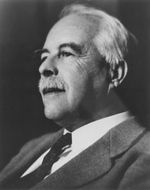Electron dot diagram
The Electron Dot Diagram is a simple but elegant way to see how many pairs of electrons an [element] has or will need to have to complete its full outer circle of eight. This diagram was created by Gilbert N.Lewis in the late 1800 to the early 1900's. He created this so that he could have a simple way of [electron configuration] and it would be easier for the people in the future to decipher elements.he created the best thing ever a simple way but a convent way to solve for chemical equations and now since he created this he wrote many papers and gave lectures on it which earned him much money.
Use
An electron dot diagram is also known as a Lewis Structure in honor of Gilbert N. Lewis who devised the diagrammatic system. Lewis Structures are used for covalent molecules. For the first part of Electron Dot Notation you must choose your element.There are two ways you can connect to elements together. First is using two double lines(like an equal sign) and the second is just using dots from the electron oxidation number. These dots are drawn to show how many bonds an element has.You must write the electron dot symbol out for each electron, place the element with the biggest group of electrons that are not paired with one another, place the left over elements around the central atoms, create as many singular bonds that you can, then create second bonds as well, after all this is done check your work by counting up the number of electrons that you have placed upon your diagram. For the second step of electron dot Notation you must count the number of valence electrons an atom has. One rule we have to follow is the rule that states that eight electrons in the outer shell mean a balanced shell(octet rule). Now that we know how many electrons are in an element we must write their symbol(such that for potassium we would put a K). If they are paired electrons then we must put that set of electrons together. We must also count the number of electrons an element has. By doing this we can also find the element in the Periodic table of Elements.
There are six rules that you must follow for creating covalent bonds. The first one is that a structure has molecular compounds made up of covalent compounds, Electrons are shared when a nonmetal bonds with another nonmetal element, a nonmetal forms covalent bonds to get eight electrons inits outer shell, electrons are found in groups of two, polyatomic ions contain usually three electrons by bonding to surrounding elements, and valence electrons number can be changed by the formula (valance=group number subtraction of ten)[1] [2]
Steps
A Lewis Structure is made up of elements from the periodic table of elements and the group of valence electrons that they have. There are only a few steps to working on Lewis Structures(Electron Dot Diagram). Your first step is to find out how many electrons it needs. The second step is to figure out how many more electrons you will need to get it to the correct amount of electrons needed.Then for the third step you must figure out how bonds are in this molecule. One bond is equal to having 2 electrons.For step four your central atom should already be chosen but if it isn't then you must choose one of the elements to use as your central atom.Step five comes and you must use your atoms to connect to the central atom using a line sorta of like an equal sign.For your seventh step you must add in your electrons with doing this you should be able to create a couple of double bonds.[3]
Gilbert N. Lewis
Gilbert N.Lewis was born on the 23 of October of the year 1875. Mr.Lewis was born in Lincoln Nebraska. He lived in Lincoln till he was about fourteen years of age. He started high school at Nebraska University. He lived in the great state of Nebraska till he transferred to Harvard his junior year of college.
He got his bachelor degree in Chemistry. He also became a teacher at Phillip Academy. He then went back to college to receive his masters degree. He was taught by Theodore Richards.Under Richard's leadership Lewis received his doctrine . After Mr.Lewis gaduated he became a teacher at Harvard. He then spent some time in Germany to study . He returned to the Americas sometime after that and became a teacher. He Traveled to the Philippine islands.There he became the superintendent of Weights and Measures. Lewis traveled to and taught at MIT while there he became the Dean of Chemistry.He also received a place at the Department of Chemistry at Berkeley. Mr.Lewis stayed as the Dean till he died of a heart attack. This happened while he was working in a lab. He died on march 26 of 1943.His life Legacy is that he created the best chemistry lab in the United States of America.
Mr.Lewis received his major in [Chemical Thermodynamics]. Lewis was determined to make Chemical Thermodynamics a thing worth studying.To do this he had to study many chemicals and their existing data already.This took many hours to do. He also wanted to explain what the Empirical Laws had to do with real gases along with concentrated solutions. He created a program used specifically for free-energy. Since he wanted to explain the Empirical laws he came up with the concepts of Fugacity, Active coefficient ,along with Ionic strength.
He created the Chemical Bonding Theory. This theory was not heard of until the year of 1912. Even though it was not well known back then. It is well known today.It was only to be used if the other theories could not work. He created a model and had it published. It was a classic chemical bond with a shared pair of electrons between different chemicals. He called his model "The Valance and Structure of Atoms and Molecules". His new developed theory was quickly learned and practiced. The chemical bond works for organic chemistry. [4] [5]
Video
This is a video just demonstrating the basics of drawing Lewis Dot Structures.
References
- ↑ Helmenstine, Ann Marie. [ThoughtCo.com Lewis Structures or Electron Dot Structures ] "What They Are and How to Draw Them'. Google. (04, March, 2017).
- ↑ Robertson,Jamie. [Sciencing.com How to Draw Electron Dot Diagrams ] How to Draw Electron Dot Diagrams. Google. (25, April, 2017).
- ↑ Helmenstine,Todd. [Thought Company.com/How to Draw a Lewis Structure.] Thoughtco. google.(4, January,2018).
- ↑ Jenson, William B. [Encyclopedia Britanica.com Gilbert N.Lewis/American Chemist] Encyclopedia Britanica. google.(28, October,2017).
- ↑ Gilbert Newton Lewis. [Chemical heritage.com Gilbert Newton Lewis] American chemist G. N. Lewis was instrumental in developing the theory of covalent bonding. google . Date (23, July,2015).
| ||||||||||||||



